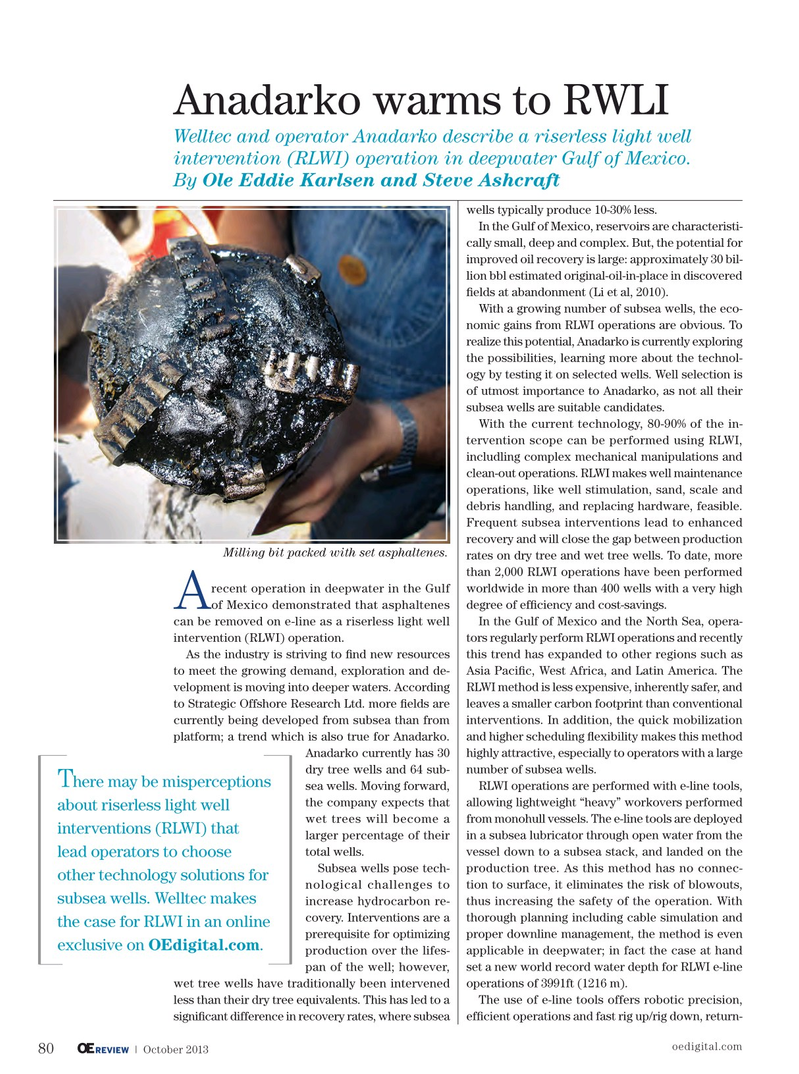
Page 78: of Offshore Engineer Magazine (Oct/Nov 2013)
Read this page in Pdf, Flash or Html5 edition of Oct/Nov 2013 Offshore Engineer Magazine
Anadarko warms to RWLI
Welltec and operator Anadarko describe a riserless light well intervention (RLWI) operation in deepwater Gulf of Mexico.
By Ole Eddie Karlsen and Steve Ashcraft wells typically produce 10-30% less.
In the Gulf of Mexico, reservoirs are characteristi- cally small, deep and complex. But, the potential for improved oil recovery is large: approximately 30 bil- lion bbl estimated original-oil-in-place in discovered felds at abandonment (Li et al, 2010).
With a growing number of subsea wells, the eco- nomic gains from RLWI operations are obvious. To realize this potential, Anadarko is currently exploring the possibilities, learning more about the technol- ogy by testing it on selected wells. Well selection is of utmost importance to Anadarko, as not all their subsea wells are suitable candidates.
With the current technology, 80-90% of the in- tervention scope can be performed using RLWI, includling complex mechanical manipulations and clean-out operations. RLWI makes well maintenance operations, like well stimulation, sand, scale and debris handling, and replacing hardware, feasible.
Frequent subsea interventions lead to enhanced recovery and will close the gap between production
Milling bit packed with set asphaltenes.
rates on dry tree and wet tree wells. To date, more than 2,000 RLWI operations have been performed recent operation in deepwater in the Gulf worldwide in more than 400 wells with a very high of Mexico demonstrated that asphaltenes degree of effciency and cost-savings.
A can be removed on e-line as a riserless light well In the Gulf of Mexico and the North Sea, opera- intervention (RLWI) operation. tors regularly perform RLWI operations and recently
As the industry is striving to fnd new resources this trend has expanded to other regions such as to meet the growing demand, exploration and de- Asia Pacifc, West Africa, and Latin America. The velopment is moving into deeper waters. According RLWI method is less expensive, inherently safer, and to Strategic Offshore Research Ltd. more felds are leaves a smaller carbon footprint than conventional currently being developed from subsea than from interventions. In addition, the quick mobilization platform; a trend which is also true for Anadarko. and higher scheduling fexibility makes this method
Anadarko currently has 30 highly attractive, especially to operators with a large dry tree wells and 64 sub- number of subsea wells.
There may be misperceptions sea wells. Moving forward, RLWI operations are performed with e-line tools, the company expects that allowing lightweight “heavy” workovers performed about riserless light well wet trees will become a from monohull vessels. The e-line tools are deployed interventions (RLWI) that larger percentage of their in a subsea lubricator through open water from the total wells. vessel down to a subsea stack, and landed on the lead operators to choose
Subsea wells pose tech- production tree. As this method has no connec- other technology solutions for nological challenges to tion to surface, it eliminates the risk of blowouts, subsea wells. Welltec makes increase hydrocarbon re- thus increasing the safety of the operation. With covery. Interventions are a thorough planning including cable simulation and the case for RLWI in an online prerequisite for optimizing proper downline management, the method is even exclusive on OEdigital.com.
production over the lifes- applicable in deepwater; in fact the case at hand pan of the well; however, set a new world record water depth for RLWI e-line wet tree wells have traditionally been intervened operations of 3991ft (1216 m).
less than their dry tree equivalents. This has led to a The use of e-line tools offers robotic precision, signifcant difference in recovery rates, where subsea effcient operations and fast rig up/rig down, return- oedigital.com
OE | October 2013REVIEW 80 080_1013OE_OERweltec.indd 80 9/29/13 11:04 PM

 77
77

 79
79